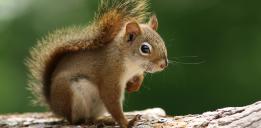 |
| Fact Sheet |
| Scientific Name |
Tamiasciurus hudsonicus |
| Description |
The red squirrel is rusty red above, with a whitish belly, gray sides, and ears that are tufted in winter. It is noted for its bright eyes, perky disposition, and chattering, rattling call. |
| Total Length |
Body - 11 to 13 inches, tail - four to five inches |
| Weight |
7 to 9 ounces |
| Color |
White belly and a top coat that is dull reddish gray in the summer and orange-red when colder weather arrives |
| Reproduction |
Red squirrels mate in late winter. They nest in hollow trees or build a 12- to 19-inch ball-shaped nest in a tree top using leaves, twigs and bark. In early spring, females have two to five babies which are born hairless and weigh less than an ounce. The young squirrels are independent within 12 weeks. |
| Food |
Squirrels eat the seeds of various conifers, acorns, mushrooms, hickory nuts, walnuts and maple seeds. After eating, it’s not uncommon for red squirrels to leave piles of shredded cones, husks and hulls more than a foot high. It commonly buries nuts and seeds, either in small piles or singly, for use on winter days. |
| Predators |
Cats, hawks, coyotes, foxes, weasels, marten and bobcats all eat red squirrels. |
| Habitat and Range |
Red squirrels live throughout our nation's snowbelt, in mountainous regions and Canada. It is most associated with coniferous woods but hardwoods and thickets, even in the northern prairies, also provide habitat. A leaf nest, usually in a tree cavity or in a crotch of a tree, is its home. |


